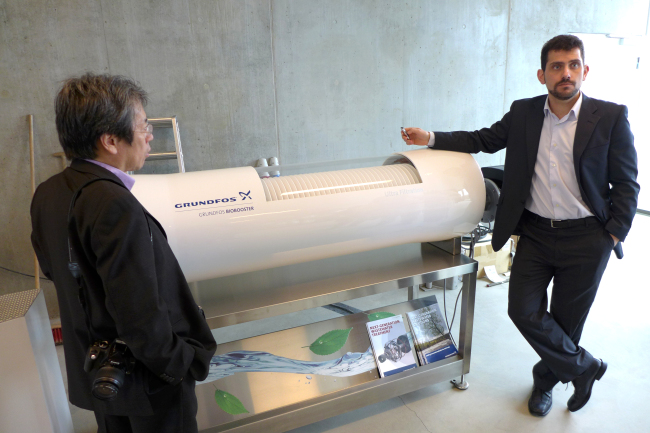COPENHAGEN ― While fighting climate change is a political debate in America, it is a way of life in Denmark. From groundwater purification to wastewater treatment and academic research to town renewals, water challenges are embodied in Danish life and business.
Denmark’s water sector has 300 companies employing 17,000 people and generating $5.2 billion annually. Nonprofit organizations such as State of Green promote Danish green technologies internationally.
“The point of departure came in 2011 when a sudden downpour caused damage to Copenhagen costing in the billions (of dollars),” said urban renewal project manager Rene Sommer Lindsay. “The event transformed the city’s political climate, ironically being ‘the best disaster ever’ in arousing consciousness about climate adaptation.”
In Copenhagen’s neighborhood of Sankt Kjelds Kvarter, town renewal combines citizen participation and city government assistance. Creative design solutions ― rain gardens, green roofs, water towers, walkways and bike paths ― were incorporated into landscape architecture.
Using detailed hydrological maps, 300 projects costing $1.5 billion were also launched, increasing roads, pipelines, retention areas and green spaces to deal with cloudbursts and floods.
Wastewater is a valuable resource in Denmark, a country known for energy efficiency. Rather than relying on the city’s centralized system, wastewater is treated locally across rural villages and small-town production facilities.
In Denmark’s second-largest city of Aarhus, a wastewater plant functions as a power plant.
“The Marselisborg Wastewater Treatment Plant is Denmark’s leading bio-refinery generating excess electricity and heat,” operations manager Flemming Husum said whil introducing the plant’s outdoor purification tanks.
“We use the newest sludge tanks made by Danfoss Power Electronics for fine bubble aeration. It reduces energy consumption and creates a surplus 3,000 kilowatts of ‘green electricity’ per day.”
 |
| Grundfos engineer Jose Antonio Gil Linares (right) speaks to reporters at the Herlev Hospital near Copenhagen, where wastewater is treated directly on the hospital premises. (Joel Lee/The Korea Herald) |
The phosphorous in the wastewater is used as fertilizer, while the biogas is used to heat water that is pumped to municipal companies for a fee, along with 40 percent of the electricity generated.
The Aarhus Water company covers all aspects of the city’s water services: supply, pipeline logistics, storm water management and wastewater treatment.
After nitrogen, phosphorous and other organic matters are removed, the purified water is released into streams, he explained.
In the small town of Kolt-Hasselager southwest of Aarhus, new residential and industrial buildings have sprouted up in recent years, increasing demand for water. Several new waterworks were built using cutting edge valves made by water equipment company AVK Group.
“We remove iron, manganese, ammonium, nitrites and nitrates from water and use automatic sand filters to prevent bacterial growth,” operations manager Allan Jensen said. “Protecting waterworks from burglary and vandalism are our top priorities, and we use video surveillance, safety checks and alarms.”
Currently, 15,000 townspeople drink water supplied by AVK, and about 100 attend annual meetings for budget and planning.
Denmark has decided to stop hospitals releasing pharmaceutical waste into local watercourses. Recognizing conventional wastewater treatment cannot remove the materials, one company developed a decentralized solution.
The Herlev Hospital near Copenhagen uses a $7 million Grundfos Biobooster, which treats wastewater directly on the premises with only five hours of weekly maintenance.
Engineer Jose Antonio Gil Linares said the Biobooster treated 90 percent of chemical components, filtering out 99 percent of each one.
“Our practice will set a benchmark for European Union and other countries,” he added.
At the end of the 15-day process, a charcoal-like waste is created and incinerated. The bacteria-free water is discharged into surrounding watercourses.
At the Technical University of Denmark in the city of Kongens Lyngby, north of Copenhagen, researchers are investigating sustainable ways of managing urban water cycles.
“We are not only ‘forecasting’ climate change, but ‘nowcasting’ its impact using real-time monitoring,” said professor Barth Smets, head of international research relations. “We combine education, innovation and consultancy in our research agenda to create value for society.”
Hwang Yu-hoon, a postdoctoral fellow in DTU’s environmental engineering department, has researched purifying contaminated groundwater using nanoparticles. He received his undergraduate and graduate degrees from the Korea Advanced Institute of Science and Technology.
“The school enables total concentration on research with its horizontal atmosphere,” Hwang said. “Open discussions encourage students to lead initiatives.”
Another asset is flexible and family-centered work hours allowing early departure for picking up children from child care centers and telecommuting.
In contrast to American engineering schools, which focus on developing new technologies, DTU optimizes solutions for existing technologies, according to Hwang. “We provide solutions wanted by the industries and collaborate with them. Students gain valuable experience.”
Studying in Denmark is convenient for Korean students, he said, as most Danes speak English. “But if you don’t speak Danish, making close friends with locals might be difficult.”
By Joel Lee, Korea Herald correspondent (joel@heraldcorp.com)



